| |
|
 |
|
Remote churches have a
peculiar fascination for me. It is as if they are
cut off in time as well as space. Things have
happened at a different pace, in different ways.
Sometimes, it seems as though they have been
forgotten, and that much has survived. In Suffolk
there are some lovely, unspoiled, remote
churches. I think of Badley, I think of Little
Wenham. But most of all I think of Wantisden.
It had been nearly twenty years since I'd last
visited Wantisden church. And yet, I had thought
of it often, and even passed it close enough to
see it off in the distance. The church is located
in fields about half a mile from the nearest
road. This is not that unusual in East Anglia,
probably a dozen others are equally remote. And
St John the Baptist has always been remote, for
there has never been a village of Wantisden. This
church served the residents of Wantisden Hall,
and their workers. |
What makes the church remarkable
however, is not its remoteness, but its location. Until
the 1930s, there were just two little cottages about 400
yards north of the church, by a bend in the little river.
They were called Bent Waters cottages. At the start of
the second world war, this whole area was requisitioned
by the military, and by 1950, USAAF Bentwaters was one of
the biggest and busiest military airbases in the world.
The site of the cottages is somewhere under the main
runway now, the river long-culverted. The church was
enclosed by the military area until the 1950s, when the
new perimeter fence cut in and put it outside the base.
However, the only access to it was through the base (the
fields were still cordoned off as tank training areas) so
anyone who wanted to tend a grave had to have a military
escort through the base. At this time, the modern top
road didn't exist, and the nearest other road to the
church was a mile away. When the fields were reopened in
the sixties, the current top road was built, and a
footpath was put in from it. In the 1980s, it was turned
into a roadway, but it was still shown on OS maps as a
footpath, perhaps because of its proximity to the
airbase. It seems that Russia wasn't the only country
during the cold war to put deliberate errors on maps to
confuse the enemy.
St John the Baptist is a Norman church, with a 15th
century Coralline Crag tower, one of only two in England.
The other is about a mile off at Chillesford, where you
can also see the medieval quarry from which the crag was
dug. Simon Cotton tells me that bequests were made for
this tower in 1445 and 1449. A derelict stable,
presumably for the rector's horse, sits on the southern
perimeter of the churchyard. Given the location of St
John the Baptist, you might think that the church has
been declared redundant, but it is still looked after as
part of the Orford benefice, a tremendous act of faith
and love.
You collect the key from the Hall Farm office at the top
of the track (of interest to fans of the BBC TV show
The Detectorists, for this is the depot where Lance
works in all three series) and step in through the small
Norman south doorway of the church into an organic space,
close to the earth from which it springs, rough and ready
and yet also lovingly kept. Above the doorway is a
grinning grotesque headstone, probably a lion, an early
medieval symbol of Christ. Turning east, the chancel arch
is Norman, a rare beast in Suffolk. Above it, the 18th
Century decalogue boards are in their original place, and
a royal arms dated 1800 hangs on the north wall.
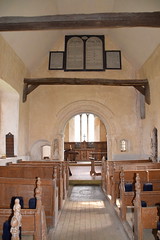 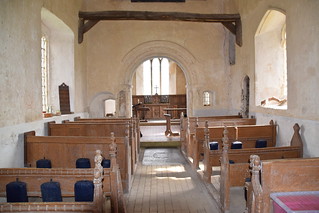 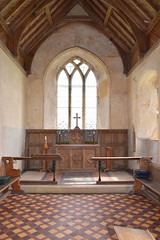
The bench ends are medieval, their
figures entirely destroyed, although enough remains of
one to show that it may well have depicted a fox
preaching to geese. They probably came from elsewhere,
but some crude 17th Century benches huddle in the north
west corner, and this was no doubt their original home.
The font is a great round tub of a thing, contemporary
with the chancel arch. It is one of England's few
surviving Norman fonts built of blocks of stone. Wall
paintings on the south nave wall are indistinct, though
you can still make out a consecration cross. The rood
loft stairs still turn up from the south-east corner of
the nave, whilst up in the chancel the wooden credence
shelf survives in the 14th Century piscina.
Ann Comyn, on the north chancel wall, exchanged time
for eternity in 1832. Mortlock observed that such a
transition seems unremarkable in a place like Wantisden.
Before that, Mary Wingfield lyved in ye trewe feare
of God and died in the faith of Christ in 1582.
Robert Harvie, one of the Harveys of Ickworth, was having
no such truck with even such puritan sentiments as these
when he died shortly before the start of the English
Civil War in 1637, his inscription simply telling us that
he died and was buried. Curiously, the inscription also
records the death of his wife Marian, who died the
- but there the inscription ends. Presumably it was
installed before her death in full expectation that she
would join him, but perhaps in the tumult and fury of the
Civil War and subsequent Commonwealth she moved
elsewhere, or was even forgotten.
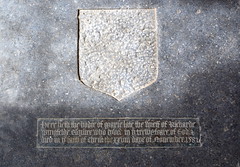 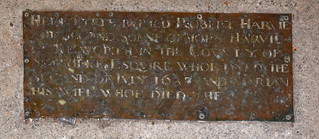
Outside in early spring, the wind
ruffles the bare trees, and the churchyard begins to
overgrow the mainly 19th Century graves. There is the
Tunstall forest in the distance, dark and forbidding. But
the most surreal view is to the west. Here, 20 metres or
so from the tower, is the perimeter fence of the USAF
base, abandoned in the early 1990s. When I last came here
in 2000 the buildings were boarded up, the control tower
had the cladding hanging off it, the runway, as wide as
Heathrow's, was overgrown, and sheep grazed all around.
Beyond were the nuclear missile bunkers, built to be
indestructible. All this has now been replaced by mundane
warehousing and storage facilities, poor neighbours to
the thousand-year-old church.
I thought back to my first visit here in the early 1990s,
watching from beneath as an F1-11 jet screamed into the
sky. It was from this base that the Americans bombed
Libya in 1987. And that same decade, while the brave
women of Greenham Common were protesting about Cruise
Missiles there (how long ago that now seems!) the US
Airforce was quietly stockpiling nuclear warheads here.
At one time, USAF Bentwaters is said to have stocked
enough nuclear weapons to destroy the world 5 times over.
And accidents do happen. In a
forgotten leaflet in the depths of Suffolk Libraries'
reserve collection, I found a story that, in the 1940s,
there was an accident at the nearby tank school. Several
people were killed, and the cracks in the walls of
Wantisden church are still there. But, this church
survives, thanks to the loving care of the local faith
community.
This is a strange place,
like no other. It stands as a witness to a
millennium of faith. The vivid sandy colour of
the coralline tower, full of fossilised shells,
rears primevally above the corrugated fields.
When I came here in 2000, a couple of elderly
parishioners were planting a millennium yew tree
in the churchyard, grown from a cutting of a tree
believed to be already a thousand years old, as
old as this church.
Time passes. And there is still a great sense of
permanence here, because the evidence is so close
at hand that, as empires rise and crumble, as the
violence of the 20th century sinks back into the
silence of these ancient fields, as the years
turn into millennia, faith endures. And so, of
course, does love. |
|
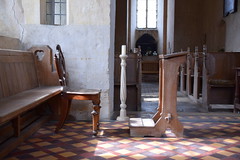 |
Simon
Knott, April 2018
|
|
|

